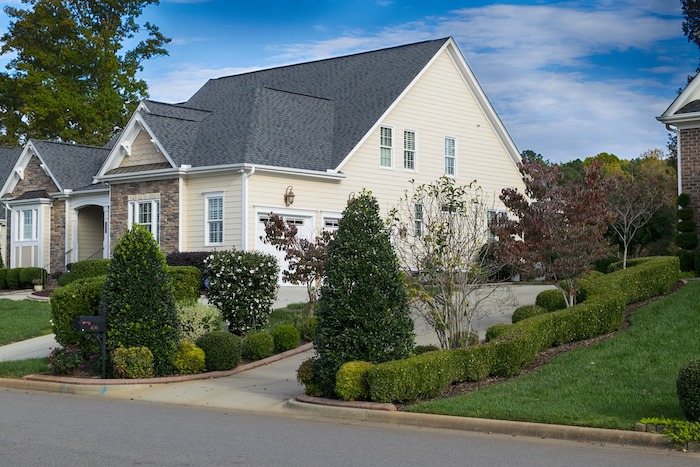The Effect of Landscaping on Property Value
Does landscaping increase property value? You bet. But you need to make the right improvements to maximize the ROI on home landscaping.
While many people get bogged down on the interior of their home when getting ready to sell, it’s surprising how much value a nice outdoor space can add to a property. The right combination of trees, plants, lighting, and patio space can increase your property value by 20 percent. Not only that, but some homebuyers will pay more for a home with good landscaping.
Potential homebuyers are looking for yards that are well-manicured, with an intentional design. They want mature plants that have had time to establish themselves. A variety of plant life can also help add impact to your landscaping and catch a person’s eye. Remember, the first impression of your home is very important when selling, and the yard is a big part of that first look.
Start with basic maintenance
The great thing about the effect of landscaping on property value is that it doesn’t require doing anything extra. Inside your home, costly upgrades like changing the floor or countertops add value. On the outside, you’ll see returns with regular care. In fact, standard lawn services, which include cutting the grass, managing weeds, and shaping larger bushes, recover 267 percent of the cost at resale. That’s a significant return for very little work, especially if you hire a lawn care service. You’ll also recover expenses for other general maintenance.
- Basic tree care recovers 100 percent of the project cost when you sell your home.
- Installing sprinklers or any type of irrigation recovers 86 percent of cost at sale time as well.
- A simple patio can cost less than $10 per square foot and potentially recoup $2 per $1 invested.
Make a plan for some upgrades
To prevent your landscaping from taking on a disorganized look, start with a plan. You don’t have to do all the planting at once, but drawing up a master design for your yard lets you work in phases without losing cohesiveness. It ensures you don’t end up with a piecemeal feel to your trees and bushes, which can turn off buyers.
Having a plan also gives you time to work well in advance of when you might want to sell your home. Since buyers seem to prefer landscapes full of large, mature plants, you want to give your yard time to grow. A yard that’s well cared for is a great sign that the interior of the home was maintained as well.
See also: 10 Home Improvements While Working From Home
Add a few more trees and shrubs
Another great thing about landscaping is it repeatedly adds value to your home. There’s the immediate increase right after you make the change, but also the value that builds up over time. Think of how pretty a sapling looks when added to your yard, or when you plant brand new gardenia bushes beside your front door. These items make an impact right from the start, but continue to do so year-over-year as they grow taller, fuller, and more robust. Those gardenia bushes will bloom each spring with perfumed, white flowers. That tree will continue branching out until you have a stately element in your yard.
The best trees for increasing property value
Adding a tree to your yard is a big investment. It’s going to be there for a long time, and continue to make a statement as it grows. Mature trees are also difficult to remove, so you want to be sure you’re making a good choice when adding one, or more, to your property. The secret is finding trees that thrive in your specific area. This way you don’t end up with trees that show damage from insects, disease, or weather. The USDA Plant Hardiness Zone Map can help narrow down your options. You can align your tree choices based on which ones thrive in the zones of your home.
Many trees fit within each range, so check to see if your favorites thrive in your neighborhood. If not, there are a lot of other options. For example, Golden Rain trees thrive anywhere in zones 5-9. Fern Pines, originally native to Eastern Africa, do well in the US in zones 9-11, at the southernmost parts of the country. Maple trees, on the other hand, prefer medium climates, but can tolerate the colder winters in zone 3.
Homes with trees are generally more sought after by buyers than those without. And, the trees alone can increase your property value by about seven percent. Get planting.
Go beyond the green grass

Bushes, trees, flowers, and lush green grass all make a strong impression on a home. Maintaining it is important, but when looking to use your landscaping to add property value to your home, don’t forget about the extras. Paved areas to walk, patios or decks, and even a strategic gazebo all add to the effect your outdoor space has on potential buyers. If you already have a deck, but it’s not looking so great, put a fresh stain on it or consider an upgrade to composite decking. Take a dirt path, worn from walking out your back door to the gate in the fence, and pave it with some nice paving stones. Little touches will enhance the work you’ve done for the green things in your yard, and make things cohesive.
Take the easy route to add value
There are a lot of choices when it comes to working on your home to increase its worth. Who doesn’t want to add 10-15 percent to their home value with just their yard? Avoid the big projects and costly upgrades that go on inside the home. At the very minimum, a few flowering bushes or plants, mulch, and some time removing weeds is all you need to invest on the outside. With the right care and thought, you can use your yard to increase your property value and make an impact when it’s time to sell.
Should your yard need a little extra love when you’re ready to sell, not to worry. Rather than listing your home on the market and risking having it sit while you get your landscape up to snuff, consider working with an off-market buyer. Their quick turnaround with an as-is offer means you don’t have to do any extra work on your home.
Ready to Get Started?
Sell as-is. Pay zero fees to Sundae. Move on your time. No repairs, cleanings, or showings.


